Centennial Furniture Company: Global Logistics Case Study Analysis
VerifiedAdded on 2022/07/29
|7
|1503
|26
Case Study
AI Summary
This case study analyzes the global logistics and distribution challenges of Centennial Furniture Company (CFC), a Canadian manufacturer of lecture podiums. The assignment examines CFC's current distribution system, which relies on a network of small boutique furniture shops, and evaluates its strengths and weaknesses. It includes a qualitative and quantitative analysis, considering factors such as transportation costs, modal strengths and weaknesses, and transit time. The study compares the performance of different distribution centers (Regina and Gatineau), focusing on road transport. The analysis aims to provide insights into how CFC can improve its logistics to handle increased demand and achieve economies of scale. The study also explores potential strategies for CFC to enhance its services and reputation in the market. The conclusion summarizes the key findings and suggests avenues for improvement, such as handling larger quantities to reduce transportation costs and attracting more customers.

Running head: Global Logistics
Global logistics
Student’s name
Institutional affiliation
Date
Global logistics
Student’s name
Institutional affiliation
Date
Paraphrase This Document
Need a fresh take? Get an instant paraphrase of this document with our AI Paraphraser
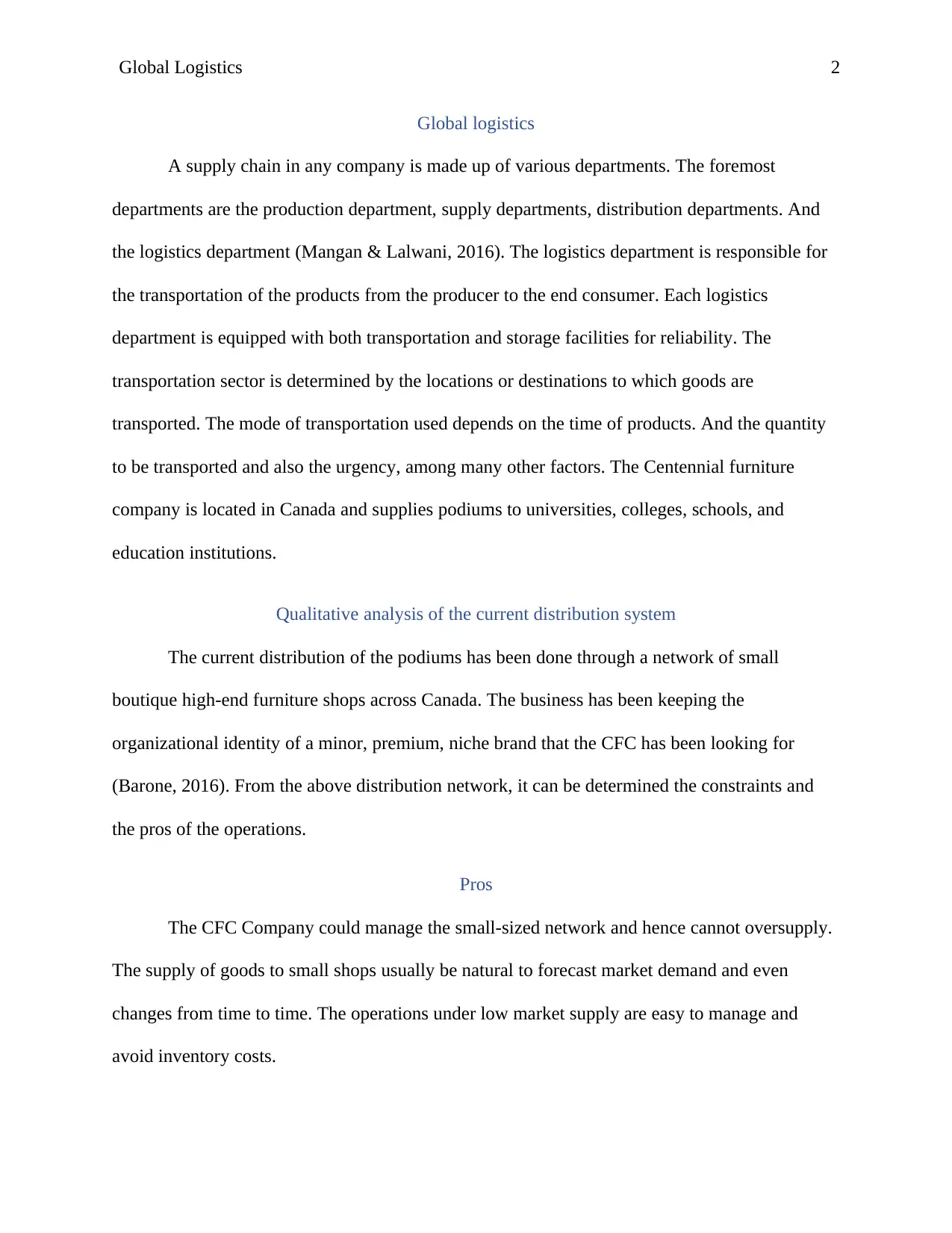
Global Logistics 2
Global logistics
A supply chain in any company is made up of various departments. The foremost
departments are the production department, supply departments, distribution departments. And
the logistics department (Mangan & Lalwani, 2016). The logistics department is responsible for
the transportation of the products from the producer to the end consumer. Each logistics
department is equipped with both transportation and storage facilities for reliability. The
transportation sector is determined by the locations or destinations to which goods are
transported. The mode of transportation used depends on the time of products. And the quantity
to be transported and also the urgency, among many other factors. The Centennial furniture
company is located in Canada and supplies podiums to universities, colleges, schools, and
education institutions.
Qualitative analysis of the current distribution system
The current distribution of the podiums has been done through a network of small
boutique high-end furniture shops across Canada. The business has been keeping the
organizational identity of a minor, premium, niche brand that the CFC has been looking for
(Barone, 2016). From the above distribution network, it can be determined the constraints and
the pros of the operations.
Pros
The CFC Company could manage the small-sized network and hence cannot oversupply.
The supply of goods to small shops usually be natural to forecast market demand and even
changes from time to time. The operations under low market supply are easy to manage and
avoid inventory costs.
Global logistics
A supply chain in any company is made up of various departments. The foremost
departments are the production department, supply departments, distribution departments. And
the logistics department (Mangan & Lalwani, 2016). The logistics department is responsible for
the transportation of the products from the producer to the end consumer. Each logistics
department is equipped with both transportation and storage facilities for reliability. The
transportation sector is determined by the locations or destinations to which goods are
transported. The mode of transportation used depends on the time of products. And the quantity
to be transported and also the urgency, among many other factors. The Centennial furniture
company is located in Canada and supplies podiums to universities, colleges, schools, and
education institutions.
Qualitative analysis of the current distribution system
The current distribution of the podiums has been done through a network of small
boutique high-end furniture shops across Canada. The business has been keeping the
organizational identity of a minor, premium, niche brand that the CFC has been looking for
(Barone, 2016). From the above distribution network, it can be determined the constraints and
the pros of the operations.
Pros
The CFC Company could manage the small-sized network and hence cannot oversupply.
The supply of goods to small shops usually be natural to forecast market demand and even
changes from time to time. The operations under low market supply are easy to manage and
avoid inventory costs.
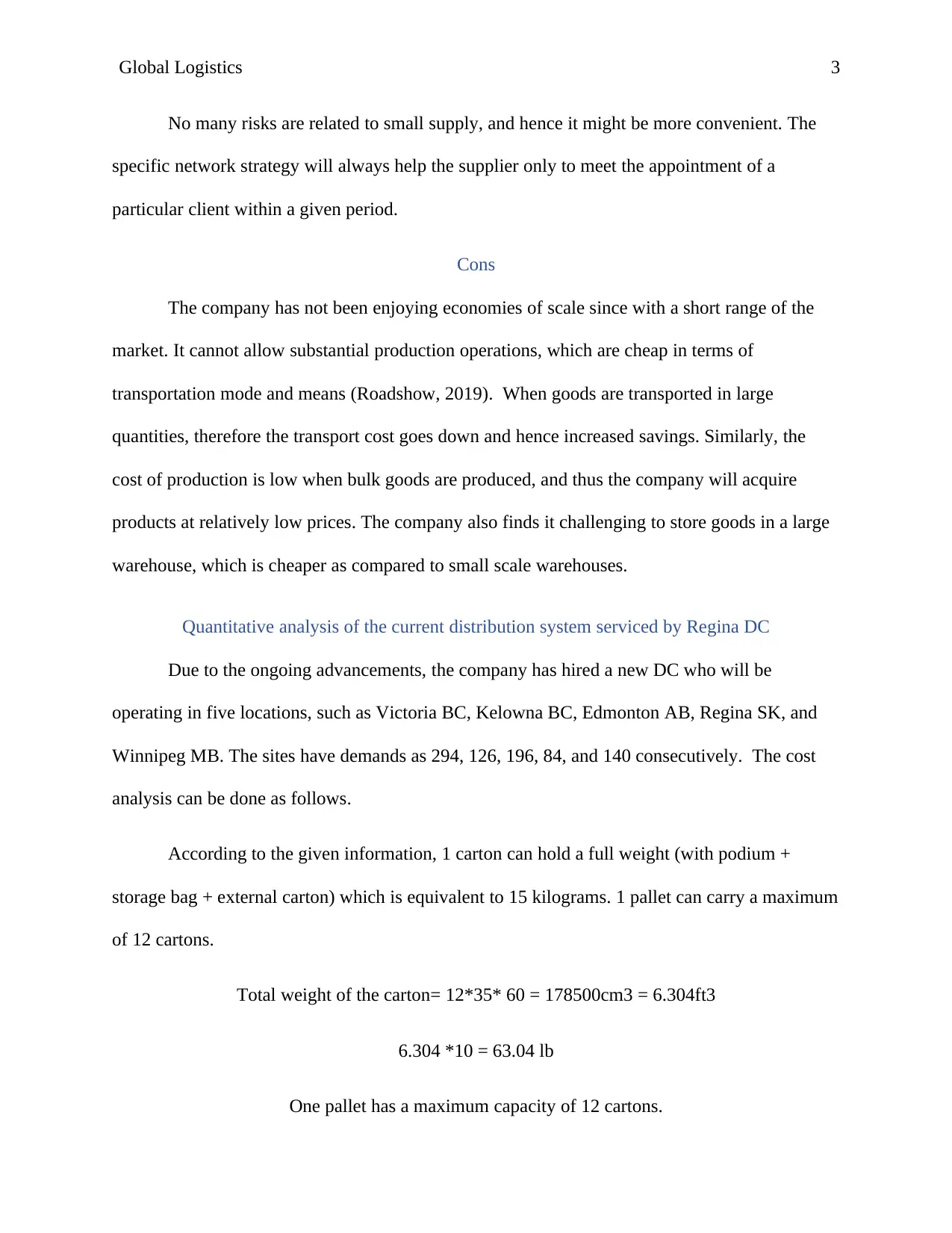
Global Logistics 3
No many risks are related to small supply, and hence it might be more convenient. The
specific network strategy will always help the supplier only to meet the appointment of a
particular client within a given period.
Cons
The company has not been enjoying economies of scale since with a short range of the
market. It cannot allow substantial production operations, which are cheap in terms of
transportation mode and means (Roadshow, 2019). When goods are transported in large
quantities, therefore the transport cost goes down and hence increased savings. Similarly, the
cost of production is low when bulk goods are produced, and thus the company will acquire
products at relatively low prices. The company also finds it challenging to store goods in a large
warehouse, which is cheaper as compared to small scale warehouses.
Quantitative analysis of the current distribution system serviced by Regina DC
Due to the ongoing advancements, the company has hired a new DC who will be
operating in five locations, such as Victoria BC, Kelowna BC, Edmonton AB, Regina SK, and
Winnipeg MB. The sites have demands as 294, 126, 196, 84, and 140 consecutively. The cost
analysis can be done as follows.
According to the given information, 1 carton can hold a full weight (with podium +
storage bag + external carton) which is equivalent to 15 kilograms. 1 pallet can carry a maximum
of 12 cartons.
Total weight of the carton= 12*35* 60 = 178500cm3 = 6.304ft3
6.304 *10 = 63.04 lb
One pallet has a maximum capacity of 12 cartons.
No many risks are related to small supply, and hence it might be more convenient. The
specific network strategy will always help the supplier only to meet the appointment of a
particular client within a given period.
Cons
The company has not been enjoying economies of scale since with a short range of the
market. It cannot allow substantial production operations, which are cheap in terms of
transportation mode and means (Roadshow, 2019). When goods are transported in large
quantities, therefore the transport cost goes down and hence increased savings. Similarly, the
cost of production is low when bulk goods are produced, and thus the company will acquire
products at relatively low prices. The company also finds it challenging to store goods in a large
warehouse, which is cheaper as compared to small scale warehouses.
Quantitative analysis of the current distribution system serviced by Regina DC
Due to the ongoing advancements, the company has hired a new DC who will be
operating in five locations, such as Victoria BC, Kelowna BC, Edmonton AB, Regina SK, and
Winnipeg MB. The sites have demands as 294, 126, 196, 84, and 140 consecutively. The cost
analysis can be done as follows.
According to the given information, 1 carton can hold a full weight (with podium +
storage bag + external carton) which is equivalent to 15 kilograms. 1 pallet can carry a maximum
of 12 cartons.
Total weight of the carton= 12*35* 60 = 178500cm3 = 6.304ft3
6.304 *10 = 63.04 lb
One pallet has a maximum capacity of 12 cartons.
⊘ This is a preview!⊘
Do you want full access?
Subscribe today to unlock all pages.

Trusted by 1+ million students worldwide
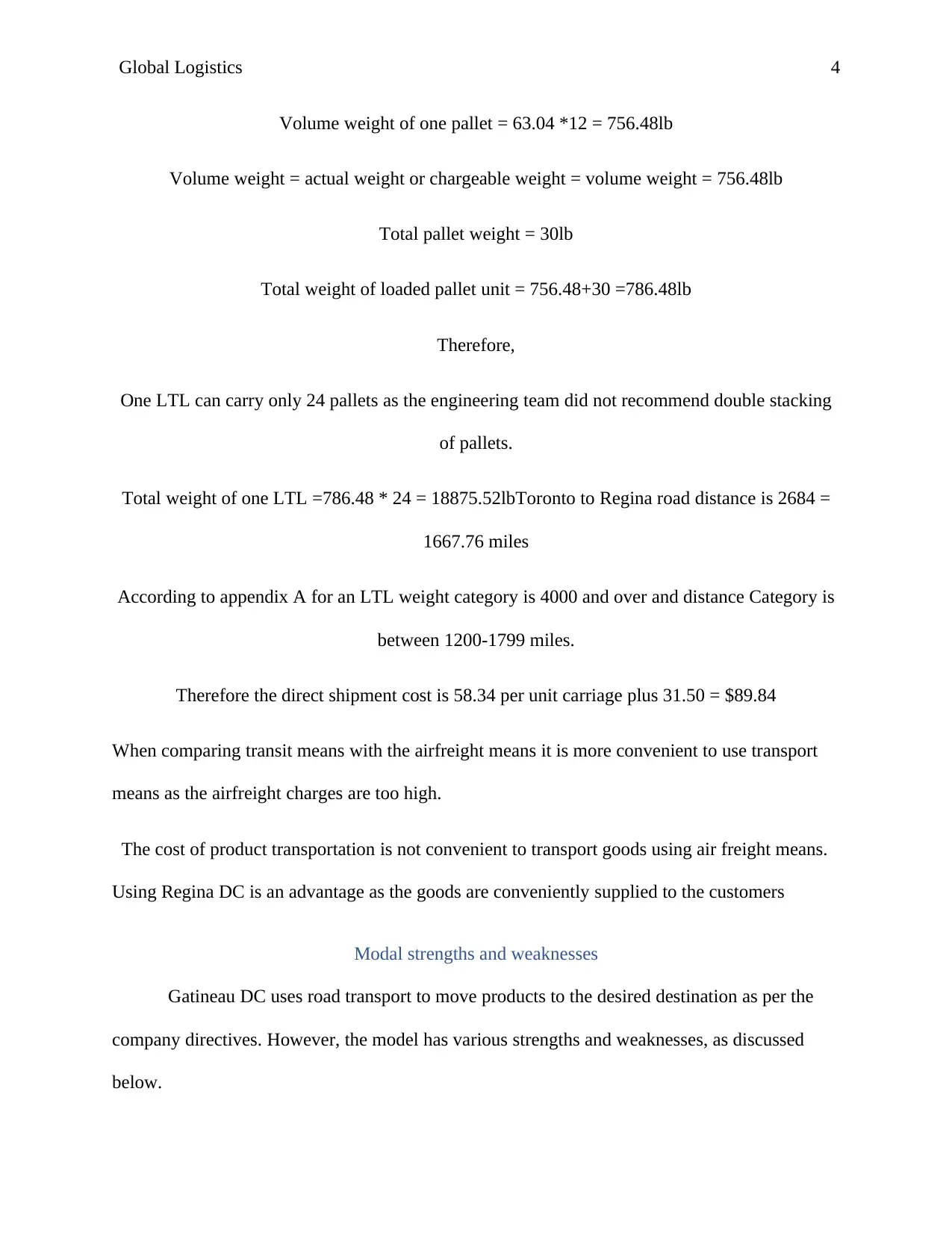
Global Logistics 4
Volume weight of one pallet = 63.04 *12 = 756.48lb
Volume weight = actual weight or chargeable weight = volume weight = 756.48lb
Total pallet weight = 30lb
Total weight of loaded pallet unit = 756.48+30 =786.48lb
Therefore,
One LTL can carry only 24 pallets as the engineering team did not recommend double stacking
of pallets.
Total weight of one LTL =786.48 * 24 = 18875.52lbToronto to Regina road distance is 2684 =
1667.76 miles
According to appendix A for an LTL weight category is 4000 and over and distance Category is
between 1200-1799 miles.
Therefore the direct shipment cost is 58.34 per unit carriage plus 31.50 = $89.84
When comparing transit means with the airfreight means it is more convenient to use transport
means as the airfreight charges are too high.
The cost of product transportation is not convenient to transport goods using air freight means.
Using Regina DC is an advantage as the goods are conveniently supplied to the customers
Modal strengths and weaknesses
Gatineau DC uses road transport to move products to the desired destination as per the
company directives. However, the model has various strengths and weaknesses, as discussed
below.
Volume weight of one pallet = 63.04 *12 = 756.48lb
Volume weight = actual weight or chargeable weight = volume weight = 756.48lb
Total pallet weight = 30lb
Total weight of loaded pallet unit = 756.48+30 =786.48lb
Therefore,
One LTL can carry only 24 pallets as the engineering team did not recommend double stacking
of pallets.
Total weight of one LTL =786.48 * 24 = 18875.52lbToronto to Regina road distance is 2684 =
1667.76 miles
According to appendix A for an LTL weight category is 4000 and over and distance Category is
between 1200-1799 miles.
Therefore the direct shipment cost is 58.34 per unit carriage plus 31.50 = $89.84
When comparing transit means with the airfreight means it is more convenient to use transport
means as the airfreight charges are too high.
The cost of product transportation is not convenient to transport goods using air freight means.
Using Regina DC is an advantage as the goods are conveniently supplied to the customers
Modal strengths and weaknesses
Gatineau DC uses road transport to move products to the desired destination as per the
company directives. However, the model has various strengths and weaknesses, as discussed
below.
Paraphrase This Document
Need a fresh take? Get an instant paraphrase of this document with our AI Paraphraser
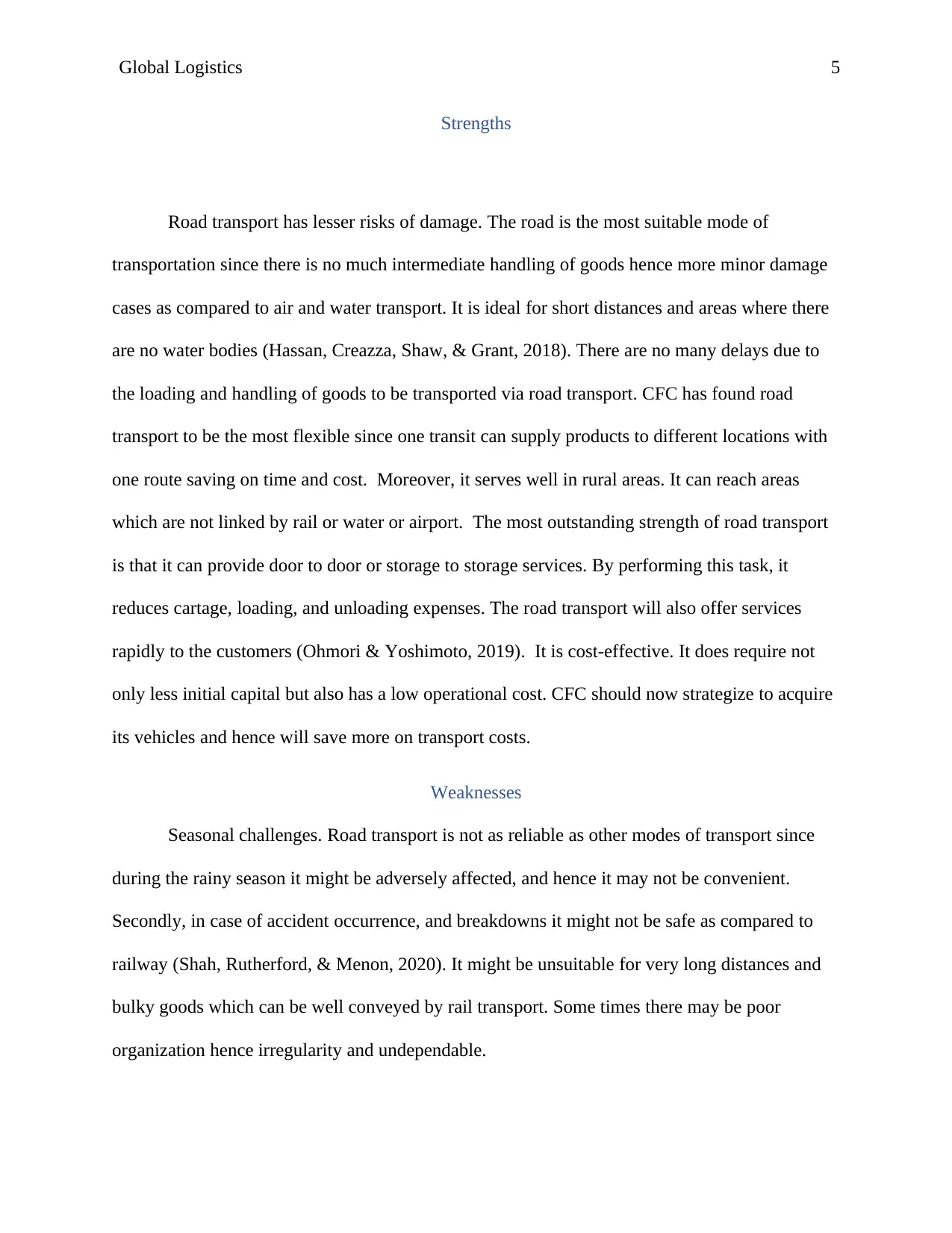
Global Logistics 5
Strengths
Road transport has lesser risks of damage. The road is the most suitable mode of
transportation since there is no much intermediate handling of goods hence more minor damage
cases as compared to air and water transport. It is ideal for short distances and areas where there
are no water bodies (Hassan, Creazza, Shaw, & Grant, 2018). There are no many delays due to
the loading and handling of goods to be transported via road transport. CFC has found road
transport to be the most flexible since one transit can supply products to different locations with
one route saving on time and cost. Moreover, it serves well in rural areas. It can reach areas
which are not linked by rail or water or airport. The most outstanding strength of road transport
is that it can provide door to door or storage to storage services. By performing this task, it
reduces cartage, loading, and unloading expenses. The road transport will also offer services
rapidly to the customers (Ohmori & Yoshimoto, 2019). It is cost-effective. It does require not
only less initial capital but also has a low operational cost. CFC should now strategize to acquire
its vehicles and hence will save more on transport costs.
Weaknesses
Seasonal challenges. Road transport is not as reliable as other modes of transport since
during the rainy season it might be adversely affected, and hence it may not be convenient.
Secondly, in case of accident occurrence, and breakdowns it might not be safe as compared to
railway (Shah, Rutherford, & Menon, 2020). It might be unsuitable for very long distances and
bulky goods which can be well conveyed by rail transport. Some times there may be poor
organization hence irregularity and undependable.
Strengths
Road transport has lesser risks of damage. The road is the most suitable mode of
transportation since there is no much intermediate handling of goods hence more minor damage
cases as compared to air and water transport. It is ideal for short distances and areas where there
are no water bodies (Hassan, Creazza, Shaw, & Grant, 2018). There are no many delays due to
the loading and handling of goods to be transported via road transport. CFC has found road
transport to be the most flexible since one transit can supply products to different locations with
one route saving on time and cost. Moreover, it serves well in rural areas. It can reach areas
which are not linked by rail or water or airport. The most outstanding strength of road transport
is that it can provide door to door or storage to storage services. By performing this task, it
reduces cartage, loading, and unloading expenses. The road transport will also offer services
rapidly to the customers (Ohmori & Yoshimoto, 2019). It is cost-effective. It does require not
only less initial capital but also has a low operational cost. CFC should now strategize to acquire
its vehicles and hence will save more on transport costs.
Weaknesses
Seasonal challenges. Road transport is not as reliable as other modes of transport since
during the rainy season it might be adversely affected, and hence it may not be convenient.
Secondly, in case of accident occurrence, and breakdowns it might not be safe as compared to
railway (Shah, Rutherford, & Menon, 2020). It might be unsuitable for very long distances and
bulky goods which can be well conveyed by rail transport. Some times there may be poor
organization hence irregularity and undependable.
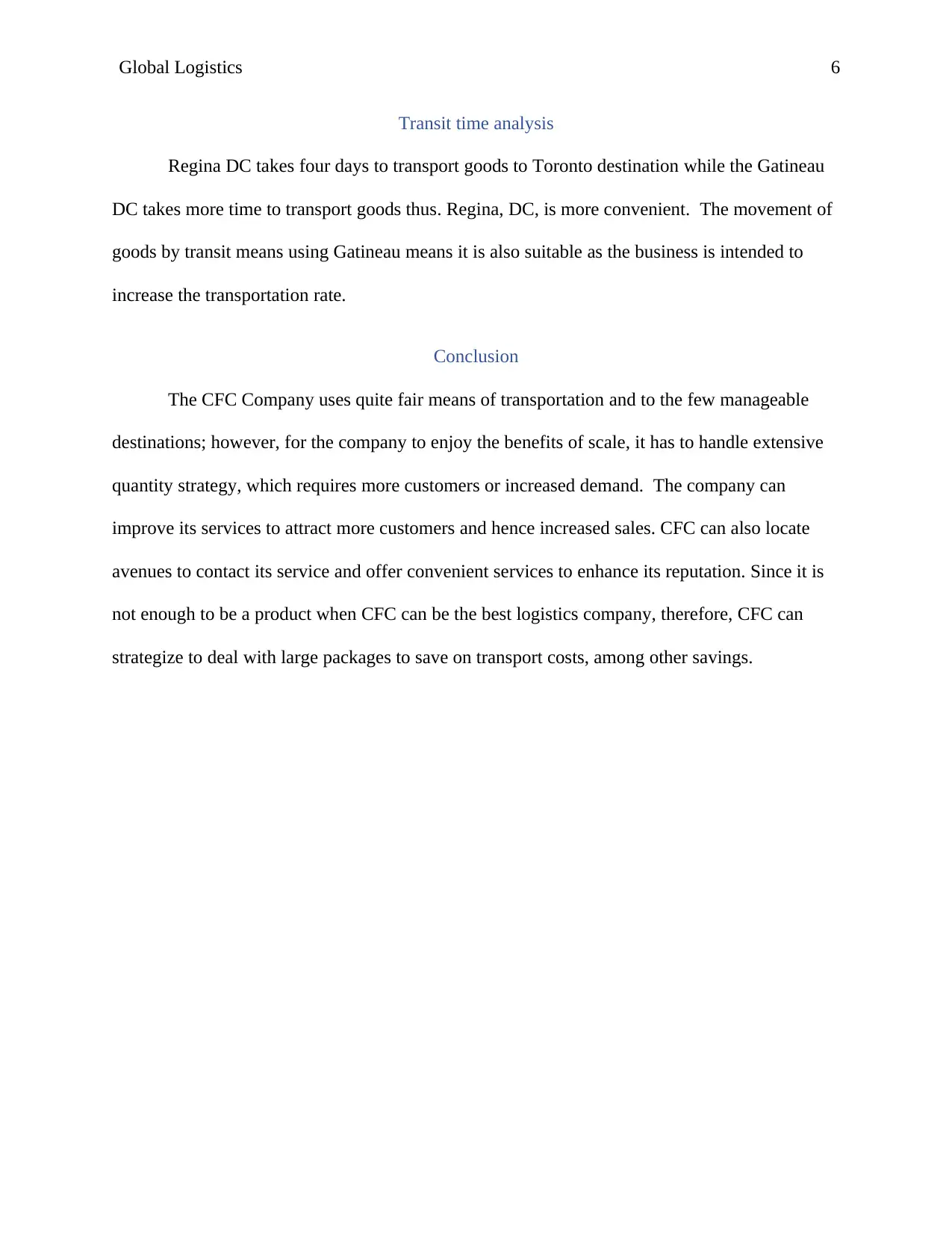
Global Logistics 6
Transit time analysis
Regina DC takes four days to transport goods to Toronto destination while the Gatineau
DC takes more time to transport goods thus. Regina, DC, is more convenient. The movement of
goods by transit means using Gatineau means it is also suitable as the business is intended to
increase the transportation rate.
Conclusion
The CFC Company uses quite fair means of transportation and to the few manageable
destinations; however, for the company to enjoy the benefits of scale, it has to handle extensive
quantity strategy, which requires more customers or increased demand. The company can
improve its services to attract more customers and hence increased sales. CFC can also locate
avenues to contact its service and offer convenient services to enhance its reputation. Since it is
not enough to be a product when CFC can be the best logistics company, therefore, CFC can
strategize to deal with large packages to save on transport costs, among other savings.
Transit time analysis
Regina DC takes four days to transport goods to Toronto destination while the Gatineau
DC takes more time to transport goods thus. Regina, DC, is more convenient. The movement of
goods by transit means using Gatineau means it is also suitable as the business is intended to
increase the transportation rate.
Conclusion
The CFC Company uses quite fair means of transportation and to the few manageable
destinations; however, for the company to enjoy the benefits of scale, it has to handle extensive
quantity strategy, which requires more customers or increased demand. The company can
improve its services to attract more customers and hence increased sales. CFC can also locate
avenues to contact its service and offer convenient services to enhance its reputation. Since it is
not enough to be a product when CFC can be the best logistics company, therefore, CFC can
strategize to deal with large packages to save on transport costs, among other savings.
⊘ This is a preview!⊘
Do you want full access?
Subscribe today to unlock all pages.

Trusted by 1+ million students worldwide
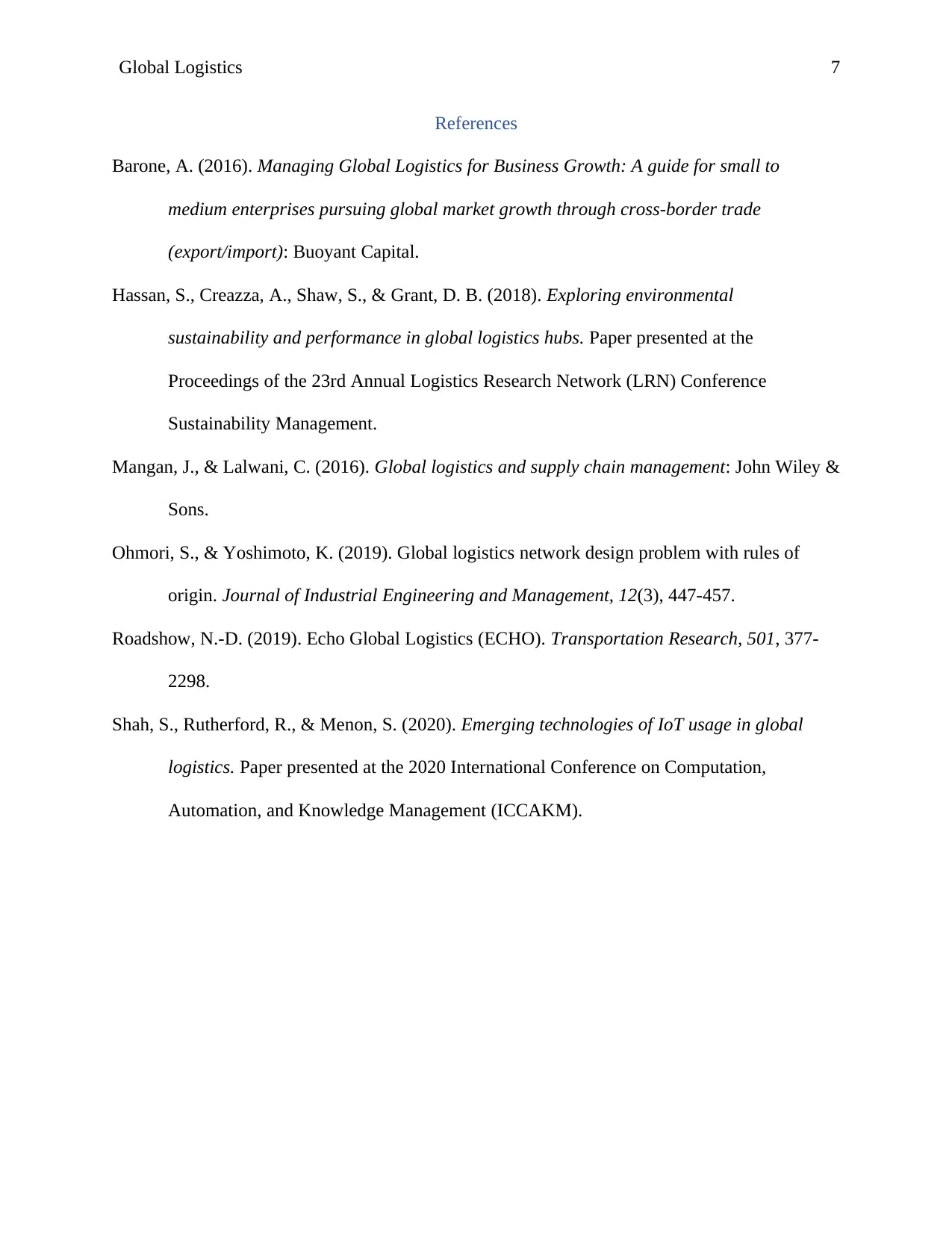
Global Logistics 7
References
Barone, A. (2016). Managing Global Logistics for Business Growth: A guide for small to
medium enterprises pursuing global market growth through cross-border trade
(export/import): Buoyant Capital.
Hassan, S., Creazza, A., Shaw, S., & Grant, D. B. (2018). Exploring environmental
sustainability and performance in global logistics hubs. Paper presented at the
Proceedings of the 23rd Annual Logistics Research Network (LRN) Conference
Sustainability Management.
Mangan, J., & Lalwani, C. (2016). Global logistics and supply chain management: John Wiley &
Sons.
Ohmori, S., & Yoshimoto, K. (2019). Global logistics network design problem with rules of
origin. Journal of Industrial Engineering and Management, 12(3), 447-457.
Roadshow, N.-D. (2019). Echo Global Logistics (ECHO). Transportation Research, 501, 377-
2298.
Shah, S., Rutherford, R., & Menon, S. (2020). Emerging technologies of IoT usage in global
logistics. Paper presented at the 2020 International Conference on Computation,
Automation, and Knowledge Management (ICCAKM).
References
Barone, A. (2016). Managing Global Logistics for Business Growth: A guide for small to
medium enterprises pursuing global market growth through cross-border trade
(export/import): Buoyant Capital.
Hassan, S., Creazza, A., Shaw, S., & Grant, D. B. (2018). Exploring environmental
sustainability and performance in global logistics hubs. Paper presented at the
Proceedings of the 23rd Annual Logistics Research Network (LRN) Conference
Sustainability Management.
Mangan, J., & Lalwani, C. (2016). Global logistics and supply chain management: John Wiley &
Sons.
Ohmori, S., & Yoshimoto, K. (2019). Global logistics network design problem with rules of
origin. Journal of Industrial Engineering and Management, 12(3), 447-457.
Roadshow, N.-D. (2019). Echo Global Logistics (ECHO). Transportation Research, 501, 377-
2298.
Shah, S., Rutherford, R., & Menon, S. (2020). Emerging technologies of IoT usage in global
logistics. Paper presented at the 2020 International Conference on Computation,
Automation, and Knowledge Management (ICCAKM).
1 out of 7
Related Documents
Your All-in-One AI-Powered Toolkit for Academic Success.
+13062052269
info@desklib.com
Available 24*7 on WhatsApp / Email
![[object Object]](/_next/static/media/star-bottom.7253800d.svg)
Unlock your academic potential
Copyright © 2020–2025 A2Z Services. All Rights Reserved. Developed and managed by ZUCOL.



